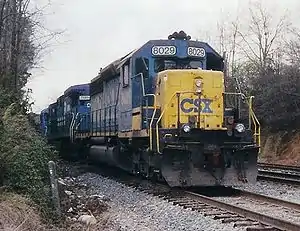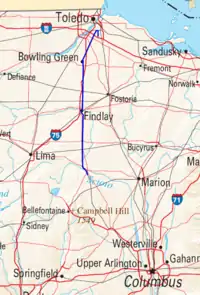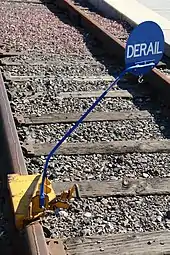CSX 8888 incident
The CSX 8888 incident, also known as the Crazy Eights incident, was a runaway train event involving a CSX Transportation freight train in the U.S. state of Ohio on May 15, 2001. Locomotive #8888, an EMD SD40-2, was pulling a train of 47 cars including some loaded with hazardous chemicals and ran uncontrolled for two hours at up to 51 miles per hour (82 km/h).[2] It was finally halted by a railroad crew in a second locomotive, which caught the runaway and coupled to the rear car.[3]
| CSX 8888 incident | |
|---|---|
 A CSX SD40-2 locomotive, similar to the locomotive involved in the incident. | |
 The train's path highlighted in blue | |
| Details | |
| Date | May 15, 2001 12:35 p.m.[1] |
| Location | Walbridge – Kenton, Ohio, U.S. 66 mi (106 km) S |
| Country | United States |
| Operator | CSX Transportation |
| Incident type | Runaway train |
| Cause | Operator error |
As of 2020, the locomotive is still in service, having been rebuilt and upgraded into a SD40-3 as part of a refurbishment program carried out by CSX, although its number is now #4389.[4] It was delivered as Conrail #6410 in September 1977.
Timeline

On May 15, 2001, a CSX locomotive engineer was using Locomotive #8888 to move a string of freight cars from track K12 to track D10 for departure on another train at Stanley Yard in Walbridge, Ohio, CSX's primary classification yard for Toledo.[2] The string consisted of 47 freight cars; 25 of them were empty, but 22 of them were fully loaded, including two tank cars containing thousands of gallons of molten phenol, a toxic ingredient used in paints, glues, and dyes that is harmful when inhaled, ingested, or comes into contact with the skin.
The engineer noticed a misaligned switch and concluded that his train, although moving slowly, would not be able to stop short of it. He decided to climb down from the train, correctly align the switch, and reboard the locomotive.
Before leaving the cab, the engineer applied the locomotive's independent air brake. During mainline operation, he would also have applied the automatic air brake, setting the brakes in each of the train's cars. But, as is normal for intra-yard movements, the air brakes of the train were disconnected from the locomotive, and thus were not functional. Furthermore, applying the locomotive's brakes disabled the train's dead man's switch, which would otherwise have applied the train brakes and cut the engine power.
The engineer also attempted to apply the locomotive's dynamic brake to slow the train to a crawl; dynamic brakes dissipate momentum (kinetic energy) by using the momentum of the train to drive the main generator, generating electricity, exactly like a regenerative braking system in a hybrid automobile, which slows the train. However, the engineer "inadvertently failed to complete the selection process", meaning that the train's engine was set to accelerate, not to brake. He then set the throttle for the traction motors at notch 8. If the dynamic brakes had been engaged as intended, this throttle setting would have used the motors against the momentum of the train, causing it to slow down. Instead, the train began to accelerate. Therefore, the only functioning brake was the air brake on the locomotive, and this was not enough to counteract its engine power.[1]
The engineer climbed down from the cab, aligned the switch, and then attempted to reboard the accelerating locomotive. However he was unable to do so and was dragged about 80 feet (24 m), receiving minor cuts and abrasions. The train rolled out of the yard and began a 65-mile (105 km) journey south through northwest Ohio unmanned.
Attempts to derail the train using a portable derailer failed, the portable derailer was thrown clear of the track due to the force of the train when it ran over it. Police also shot at an emergency fuel cutoff switch, which had no effect because the button must be pressed for several seconds before the engine would be starved of fuel and shut down. A northbound freight train, Q636-15, was directed onto a siding where the crew uncoupled its locomotive, #8392 (another EMD SD40-2), and waited for the runaway train to pass. #8392 had a crew of two: Jess Knowlton, an engineer with 31 years of service; and Terry L. Forson, a conductor with one year's experience.[5] Together they chased the runaway train. An EMD GP40-2, CSX locomotive #6008, was prepared further down the line to couple to the front of the runaway to slow it further, if necessary.
Knowlton and Forson successfully coupled onto the rear car and slowed the train by applying the dynamic brakes on the chase locomotive. Once the runaway had slowed to 11 miles per hour (18 km/h), CSX trainmaster Jon Hosfeld ran alongside the train, climbed aboard, and shut down the engine. The train was stopped just southeast of Kenton before reaching the GP40-2.[1] All the brake shoes on #8888 had been destroyed by the heat from being applied throughout the runaway trip.
CSX never publicly shared the name of the engineer who caused the runaway, nor what disciplinary action was taken. However, on YouTube, an individual had shared unconfirmed information on this in a comment on a video that reconstructed the runaway in Train Simulator. The individual had shared that the Engineer - a 31 year veteran with a perfect company record until the runaway - did not get fired, but rather got a sixty-day suspension.
Preservation attempts
Several railway museums had tried to buy #8888, but CSX officials replied that they did not feel the locomotive was worthy of preservation and that it would be rebuilt as part of the SD40-3 rebuild program in late 2014 and early 2015. The locomotive operates as CSX SD40-3 #4389.[4]
In film
The incident inspired the 2010 movie Unstoppable.[6]
References
- Kohlin, Ron. "CSX 8888 Runaway Investigation". Kohlin. Retrieved 18 February 2015.
- "Station: Stanley Yard, Ohio". Michigan's Internet Railroad History Museum. Archived from the original on 2015-11-01. Retrieved December 17, 2015.
- "Runaway train stopped after uncontrolled 2 hours". CNN. May 16, 2001. Archived from the original on February 11, 2006. Retrieved February 24, 2007.
- Lambert, Jason (2016-06-01). "Canadian Railway Observations: South of the Border". canadianrailwayobservations.com. Retrieved 2018-08-16.
- Worden, Amy (November 12, 2010). "Pennsylvania man lived the drama that inspired 'Unstoppable'". The Philadelphia Inquirer.
- David Patch (November 12, 2010). "At times, 'Unstoppable' goes off track from reality". Toledo Blade.